Airline Business Model Transformation: Effects on Tourism & Community
VerifiedAdded on 2023/03/31
|58
|19706
|238
Thesis and Dissertation
AI Summary
This thesis examines the transformation of airline business models and their impact on the international environment, including network, tourism, and social aspects. It begins with an introduction to the airline industry's growth and the influence of changing business models on tourism. The research explores the external environment through PESTEL analysis, identifies key drivers like the increasing demand for low-cost flights and technological integration, and analyzes internal operations using Porter's Value Chain model and SWOT analysis. Different airline business models, such as legacy, low-cost, and hybrid airlines, are compared. The study also investigates the historical context of the airline industry, the effects of business transformation on networks, tourism, communities, and the workforce. The conclusion links the findings with the research objectives, acknowledges limitations, and suggests future research directions. Desklib provides access to similar documents and study tools for students.
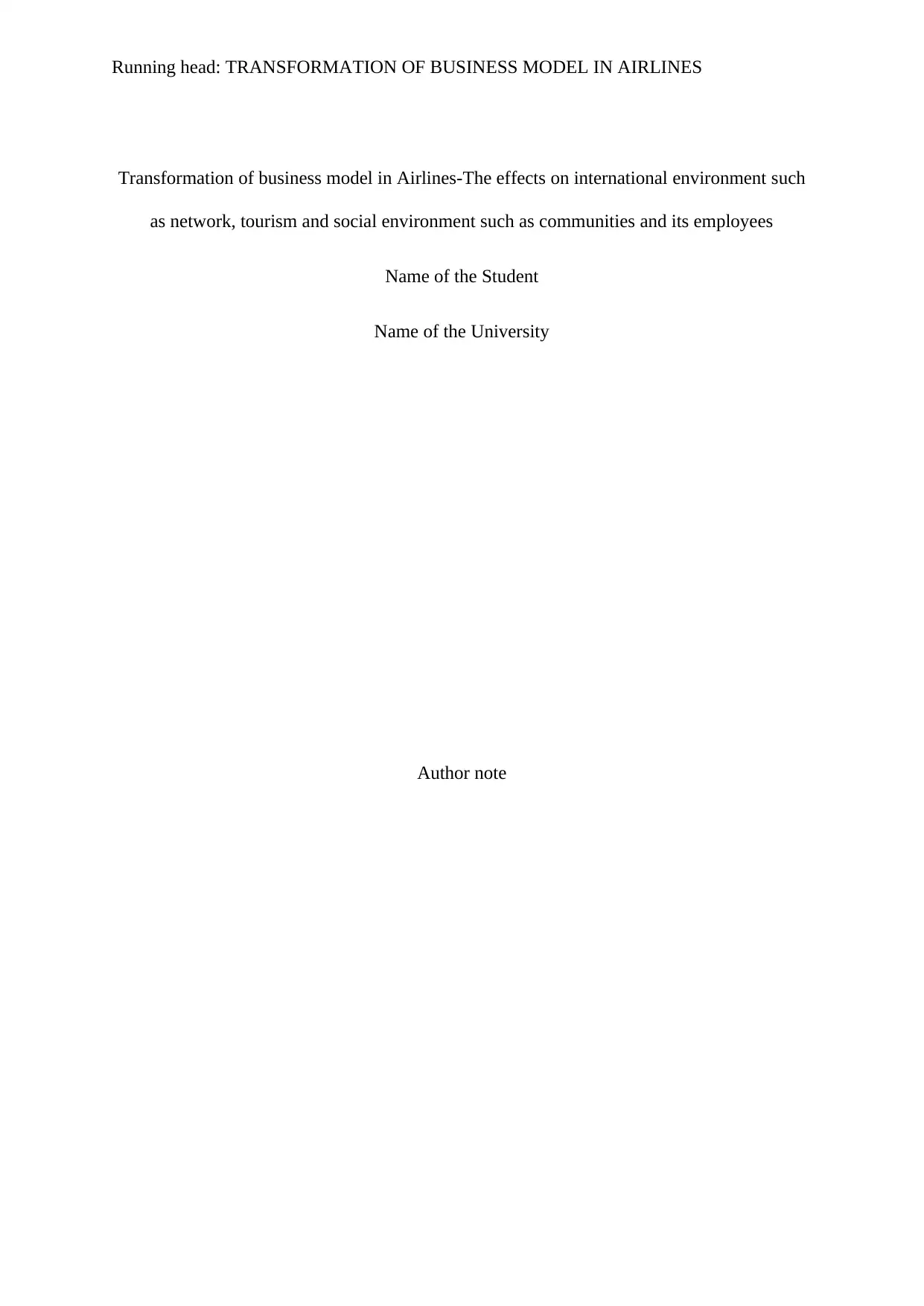
Running head: TRANSFORMATION OF BUSINESS MODEL IN AIRLINES
Transformation of business model in Airlines-The effects on international environment such
as network, tourism and social environment such as communities and its employees
Name of the Student
Name of the University
Author note
Transformation of business model in Airlines-The effects on international environment such
as network, tourism and social environment such as communities and its employees
Name of the Student
Name of the University
Author note
Paraphrase This Document
Need a fresh take? Get an instant paraphrase of this document with our AI Paraphraser
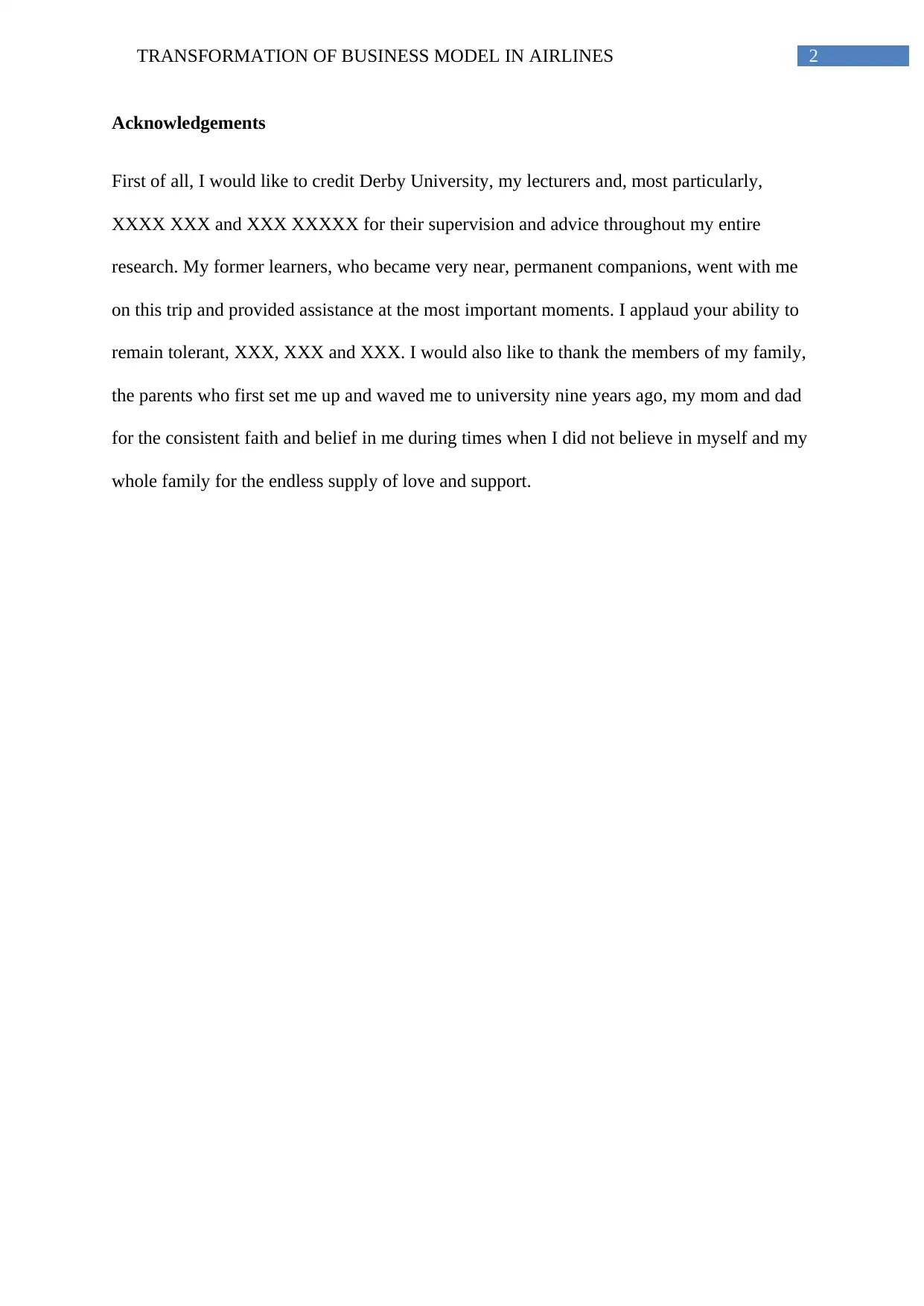
2TRANSFORMATION OF BUSINESS MODEL IN AIRLINES
Acknowledgements
First of all, I would like to credit Derby University, my lecturers and, most particularly,
XXXX XXX and XXX XXXXX for their supervision and advice throughout my entire
research. My former learners, who became very near, permanent companions, went with me
on this trip and provided assistance at the most important moments. I applaud your ability to
remain tolerant, XXX, XXX and XXX. I would also like to thank the members of my family,
the parents who first set me up and waved me to university nine years ago, my mom and dad
for the consistent faith and belief in me during times when I did not believe in myself and my
whole family for the endless supply of love and support.
Acknowledgements
First of all, I would like to credit Derby University, my lecturers and, most particularly,
XXXX XXX and XXX XXXXX for their supervision and advice throughout my entire
research. My former learners, who became very near, permanent companions, went with me
on this trip and provided assistance at the most important moments. I applaud your ability to
remain tolerant, XXX, XXX and XXX. I would also like to thank the members of my family,
the parents who first set me up and waved me to university nine years ago, my mom and dad
for the consistent faith and belief in me during times when I did not believe in myself and my
whole family for the endless supply of love and support.
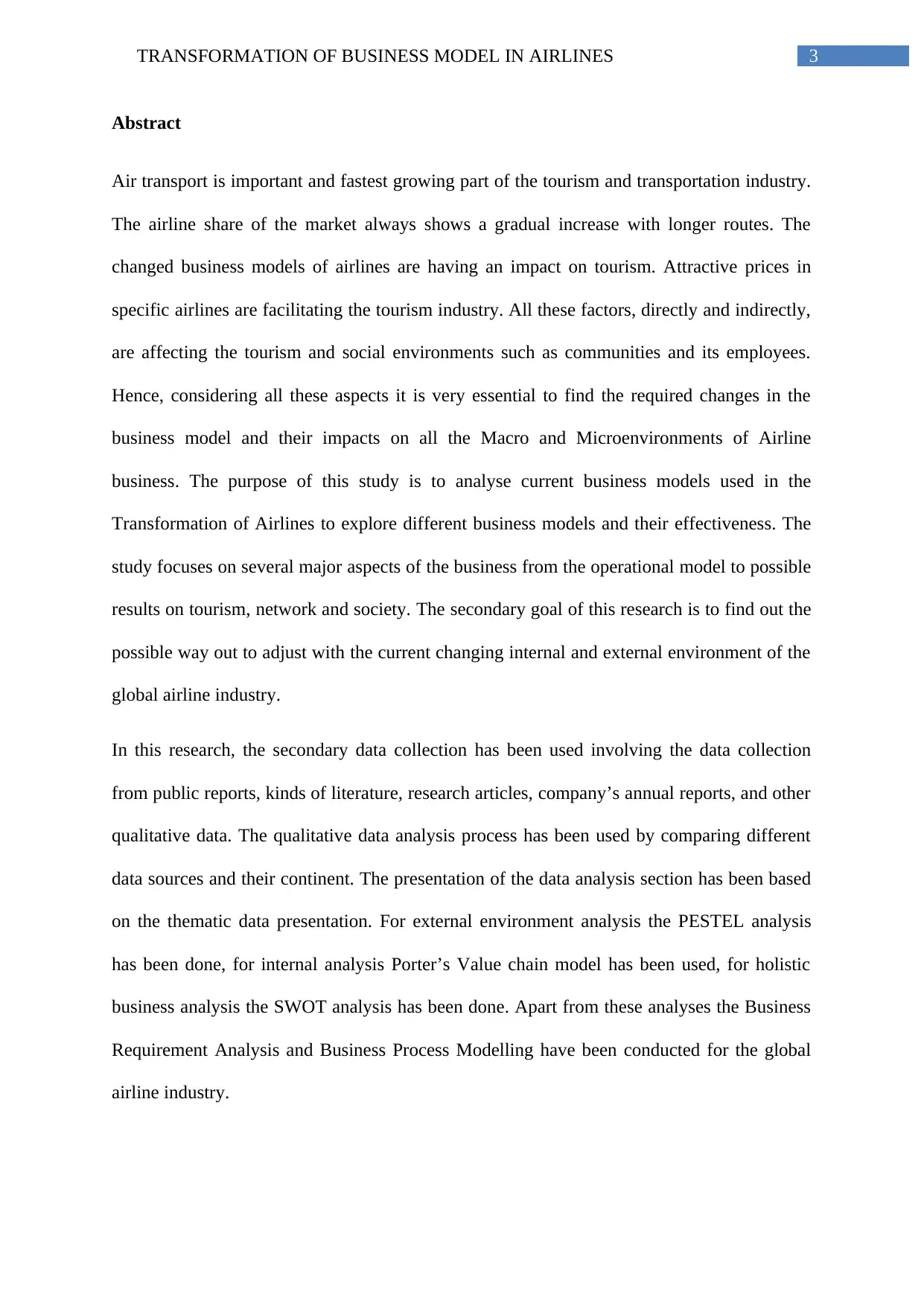
3TRANSFORMATION OF BUSINESS MODEL IN AIRLINES
Abstract
Air transport is important and fastest growing part of the tourism and transportation industry.
The airline share of the market always shows a gradual increase with longer routes. The
changed business models of airlines are having an impact on tourism. Attractive prices in
specific airlines are facilitating the tourism industry. All these factors, directly and indirectly,
are affecting the tourism and social environments such as communities and its employees.
Hence, considering all these aspects it is very essential to find the required changes in the
business model and their impacts on all the Macro and Microenvironments of Airline
business. The purpose of this study is to analyse current business models used in the
Transformation of Airlines to explore different business models and their effectiveness. The
study focuses on several major aspects of the business from the operational model to possible
results on tourism, network and society. The secondary goal of this research is to find out the
possible way out to adjust with the current changing internal and external environment of the
global airline industry.
In this research, the secondary data collection has been used involving the data collection
from public reports, kinds of literature, research articles, company’s annual reports, and other
qualitative data. The qualitative data analysis process has been used by comparing different
data sources and their continent. The presentation of the data analysis section has been based
on the thematic data presentation. For external environment analysis the PESTEL analysis
has been done, for internal analysis Porter’s Value chain model has been used, for holistic
business analysis the SWOT analysis has been done. Apart from these analyses the Business
Requirement Analysis and Business Process Modelling have been conducted for the global
airline industry.
Abstract
Air transport is important and fastest growing part of the tourism and transportation industry.
The airline share of the market always shows a gradual increase with longer routes. The
changed business models of airlines are having an impact on tourism. Attractive prices in
specific airlines are facilitating the tourism industry. All these factors, directly and indirectly,
are affecting the tourism and social environments such as communities and its employees.
Hence, considering all these aspects it is very essential to find the required changes in the
business model and their impacts on all the Macro and Microenvironments of Airline
business. The purpose of this study is to analyse current business models used in the
Transformation of Airlines to explore different business models and their effectiveness. The
study focuses on several major aspects of the business from the operational model to possible
results on tourism, network and society. The secondary goal of this research is to find out the
possible way out to adjust with the current changing internal and external environment of the
global airline industry.
In this research, the secondary data collection has been used involving the data collection
from public reports, kinds of literature, research articles, company’s annual reports, and other
qualitative data. The qualitative data analysis process has been used by comparing different
data sources and their continent. The presentation of the data analysis section has been based
on the thematic data presentation. For external environment analysis the PESTEL analysis
has been done, for internal analysis Porter’s Value chain model has been used, for holistic
business analysis the SWOT analysis has been done. Apart from these analyses the Business
Requirement Analysis and Business Process Modelling have been conducted for the global
airline industry.
⊘ This is a preview!⊘
Do you want full access?
Subscribe today to unlock all pages.

Trusted by 1+ million students worldwide
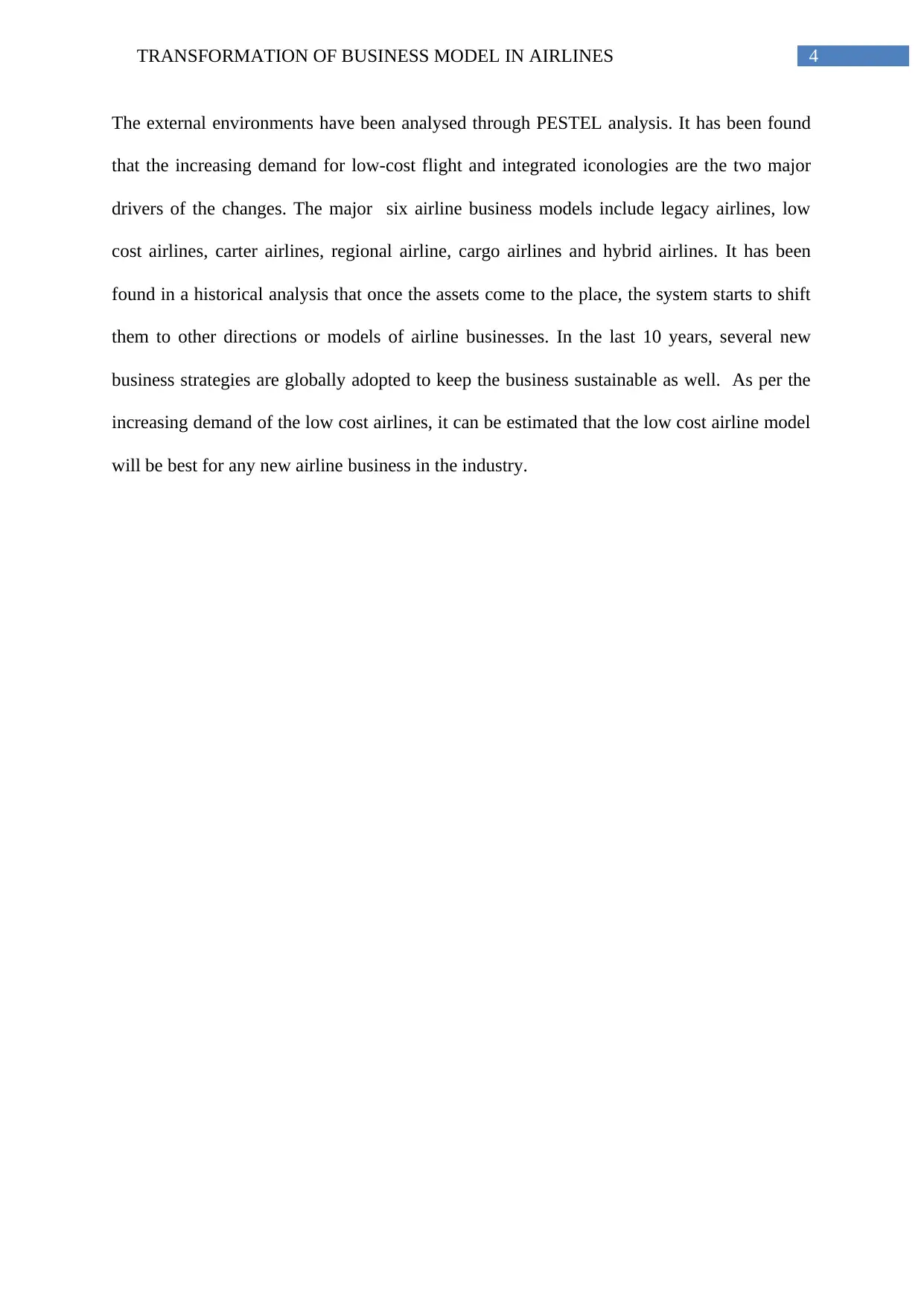
4TRANSFORMATION OF BUSINESS MODEL IN AIRLINES
The external environments have been analysed through PESTEL analysis. It has been found
that the increasing demand for low-cost flight and integrated iconologies are the two major
drivers of the changes. The major six airline business models include legacy airlines, low
cost airlines, carter airlines, regional airline, cargo airlines and hybrid airlines. It has been
found in a historical analysis that once the assets come to the place, the system starts to shift
them to other directions or models of airline businesses. In the last 10 years, several new
business strategies are globally adopted to keep the business sustainable as well. As per the
increasing demand of the low cost airlines, it can be estimated that the low cost airline model
will be best for any new airline business in the industry.
The external environments have been analysed through PESTEL analysis. It has been found
that the increasing demand for low-cost flight and integrated iconologies are the two major
drivers of the changes. The major six airline business models include legacy airlines, low
cost airlines, carter airlines, regional airline, cargo airlines and hybrid airlines. It has been
found in a historical analysis that once the assets come to the place, the system starts to shift
them to other directions or models of airline businesses. In the last 10 years, several new
business strategies are globally adopted to keep the business sustainable as well. As per the
increasing demand of the low cost airlines, it can be estimated that the low cost airline model
will be best for any new airline business in the industry.
Paraphrase This Document
Need a fresh take? Get an instant paraphrase of this document with our AI Paraphraser
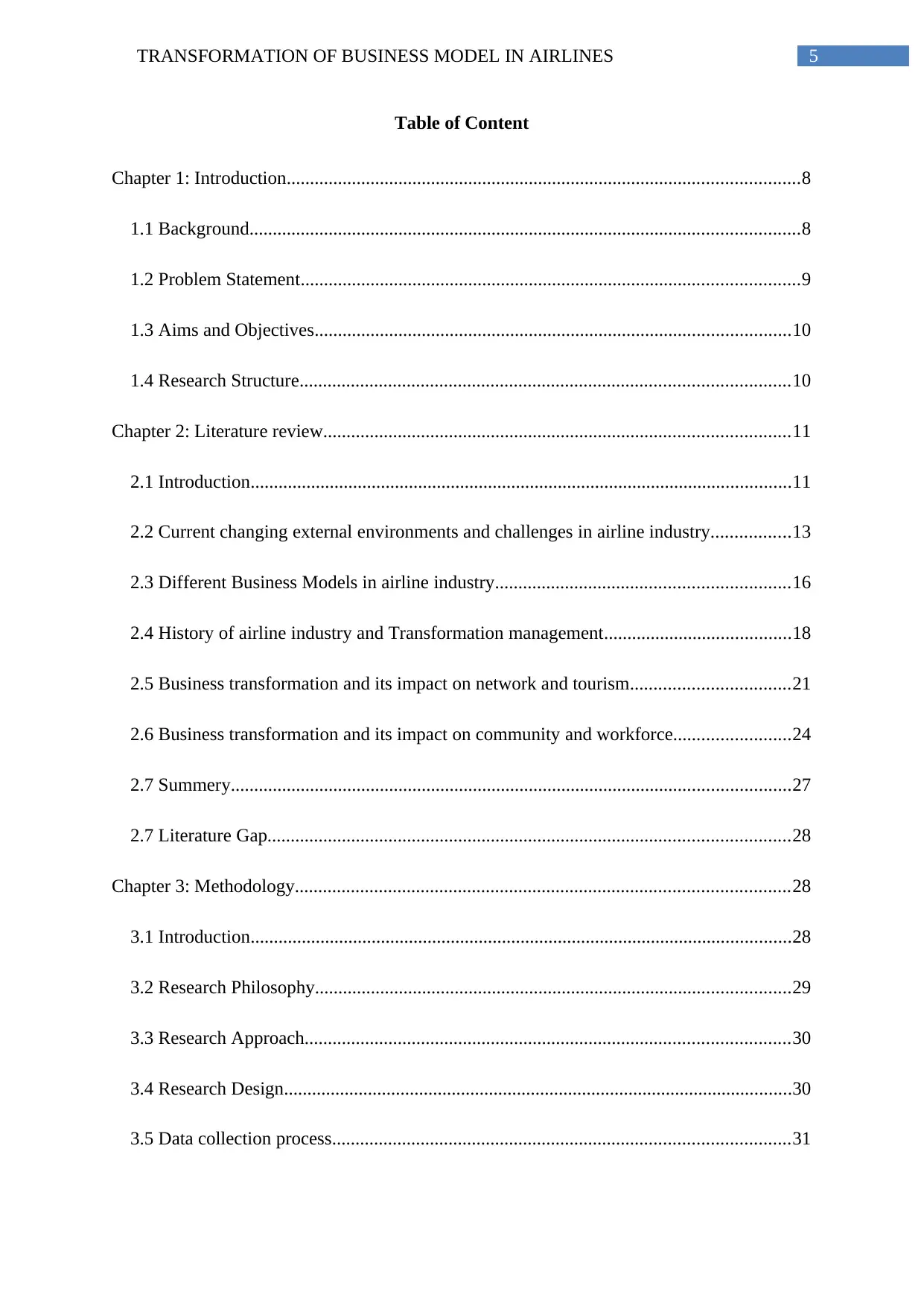
5TRANSFORMATION OF BUSINESS MODEL IN AIRLINES
Table of Content
Chapter 1: Introduction..............................................................................................................8
1.1 Background......................................................................................................................8
1.2 Problem Statement...........................................................................................................9
1.3 Aims and Objectives......................................................................................................10
1.4 Research Structure.........................................................................................................10
Chapter 2: Literature review....................................................................................................11
2.1 Introduction....................................................................................................................11
2.2 Current changing external environments and challenges in airline industry.................13
2.3 Different Business Models in airline industry...............................................................16
2.4 History of airline industry and Transformation management........................................18
2.5 Business transformation and its impact on network and tourism..................................21
2.6 Business transformation and its impact on community and workforce.........................24
2.7 Summery........................................................................................................................27
2.7 Literature Gap................................................................................................................28
Chapter 3: Methodology..........................................................................................................28
3.1 Introduction....................................................................................................................28
3.2 Research Philosophy......................................................................................................29
3.3 Research Approach........................................................................................................30
3.4 Research Design.............................................................................................................30
3.5 Data collection process..................................................................................................31
Table of Content
Chapter 1: Introduction..............................................................................................................8
1.1 Background......................................................................................................................8
1.2 Problem Statement...........................................................................................................9
1.3 Aims and Objectives......................................................................................................10
1.4 Research Structure.........................................................................................................10
Chapter 2: Literature review....................................................................................................11
2.1 Introduction....................................................................................................................11
2.2 Current changing external environments and challenges in airline industry.................13
2.3 Different Business Models in airline industry...............................................................16
2.4 History of airline industry and Transformation management........................................18
2.5 Business transformation and its impact on network and tourism..................................21
2.6 Business transformation and its impact on community and workforce.........................24
2.7 Summery........................................................................................................................27
2.7 Literature Gap................................................................................................................28
Chapter 3: Methodology..........................................................................................................28
3.1 Introduction....................................................................................................................28
3.2 Research Philosophy......................................................................................................29
3.3 Research Approach........................................................................................................30
3.4 Research Design.............................................................................................................30
3.5 Data collection process..................................................................................................31
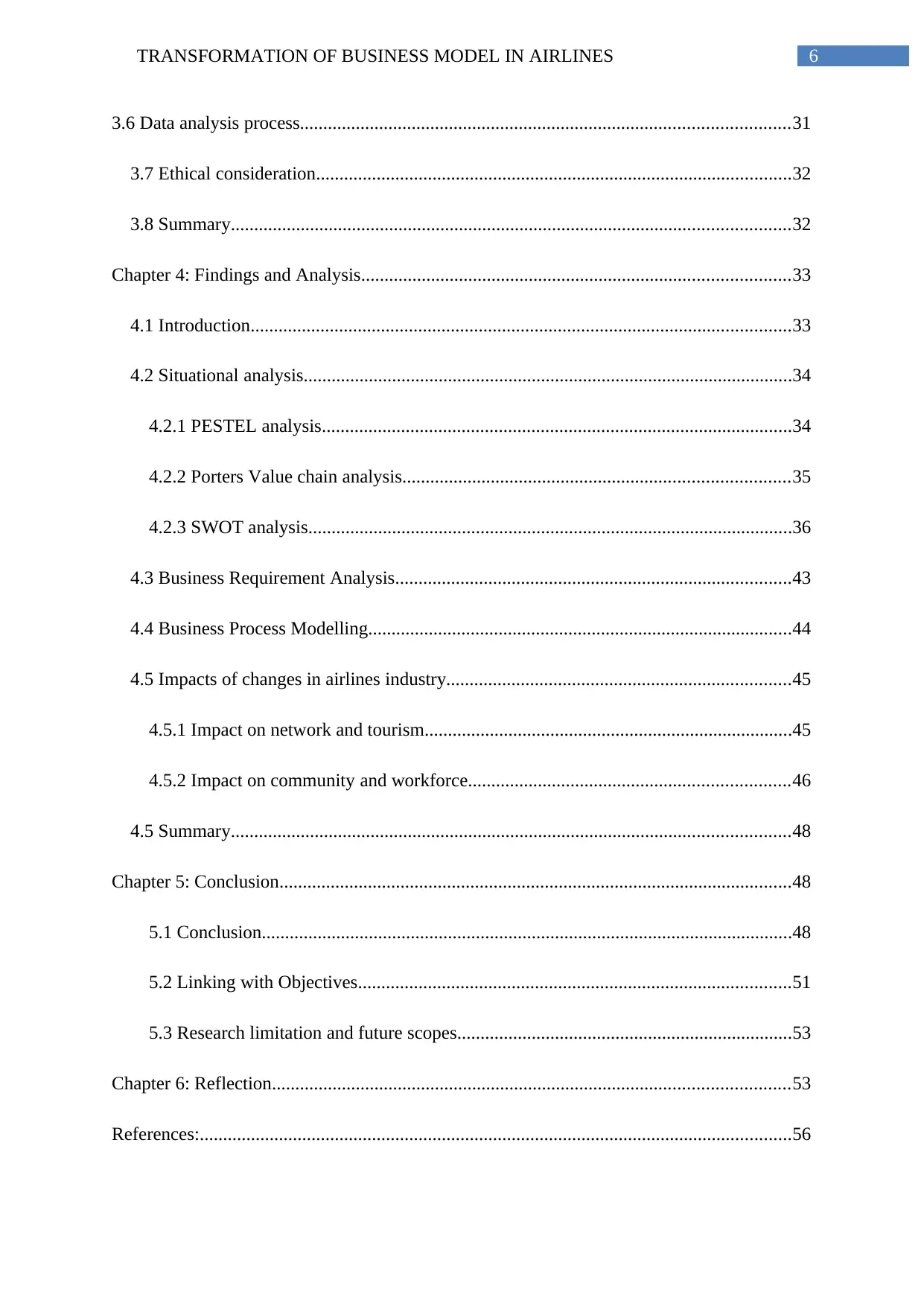
6TRANSFORMATION OF BUSINESS MODEL IN AIRLINES
3.6 Data analysis process.........................................................................................................31
3.7 Ethical consideration......................................................................................................32
3.8 Summary........................................................................................................................32
Chapter 4: Findings and Analysis............................................................................................33
4.1 Introduction....................................................................................................................33
4.2 Situational analysis.........................................................................................................34
4.2.1 PESTEL analysis.....................................................................................................34
4.2.2 Porters Value chain analysis...................................................................................35
4.2.3 SWOT analysis........................................................................................................36
4.3 Business Requirement Analysis.....................................................................................43
4.4 Business Process Modelling...........................................................................................44
4.5 Impacts of changes in airlines industry..........................................................................45
4.5.1 Impact on network and tourism...............................................................................45
4.5.2 Impact on community and workforce.....................................................................46
4.5 Summary........................................................................................................................48
Chapter 5: Conclusion..............................................................................................................48
5.1 Conclusion..................................................................................................................48
5.2 Linking with Objectives.............................................................................................51
5.3 Research limitation and future scopes........................................................................53
Chapter 6: Reflection...............................................................................................................53
References:...............................................................................................................................56
3.6 Data analysis process.........................................................................................................31
3.7 Ethical consideration......................................................................................................32
3.8 Summary........................................................................................................................32
Chapter 4: Findings and Analysis............................................................................................33
4.1 Introduction....................................................................................................................33
4.2 Situational analysis.........................................................................................................34
4.2.1 PESTEL analysis.....................................................................................................34
4.2.2 Porters Value chain analysis...................................................................................35
4.2.3 SWOT analysis........................................................................................................36
4.3 Business Requirement Analysis.....................................................................................43
4.4 Business Process Modelling...........................................................................................44
4.5 Impacts of changes in airlines industry..........................................................................45
4.5.1 Impact on network and tourism...............................................................................45
4.5.2 Impact on community and workforce.....................................................................46
4.5 Summary........................................................................................................................48
Chapter 5: Conclusion..............................................................................................................48
5.1 Conclusion..................................................................................................................48
5.2 Linking with Objectives.............................................................................................51
5.3 Research limitation and future scopes........................................................................53
Chapter 6: Reflection...............................................................................................................53
References:...............................................................................................................................56
⊘ This is a preview!⊘
Do you want full access?
Subscribe today to unlock all pages.

Trusted by 1+ million students worldwide
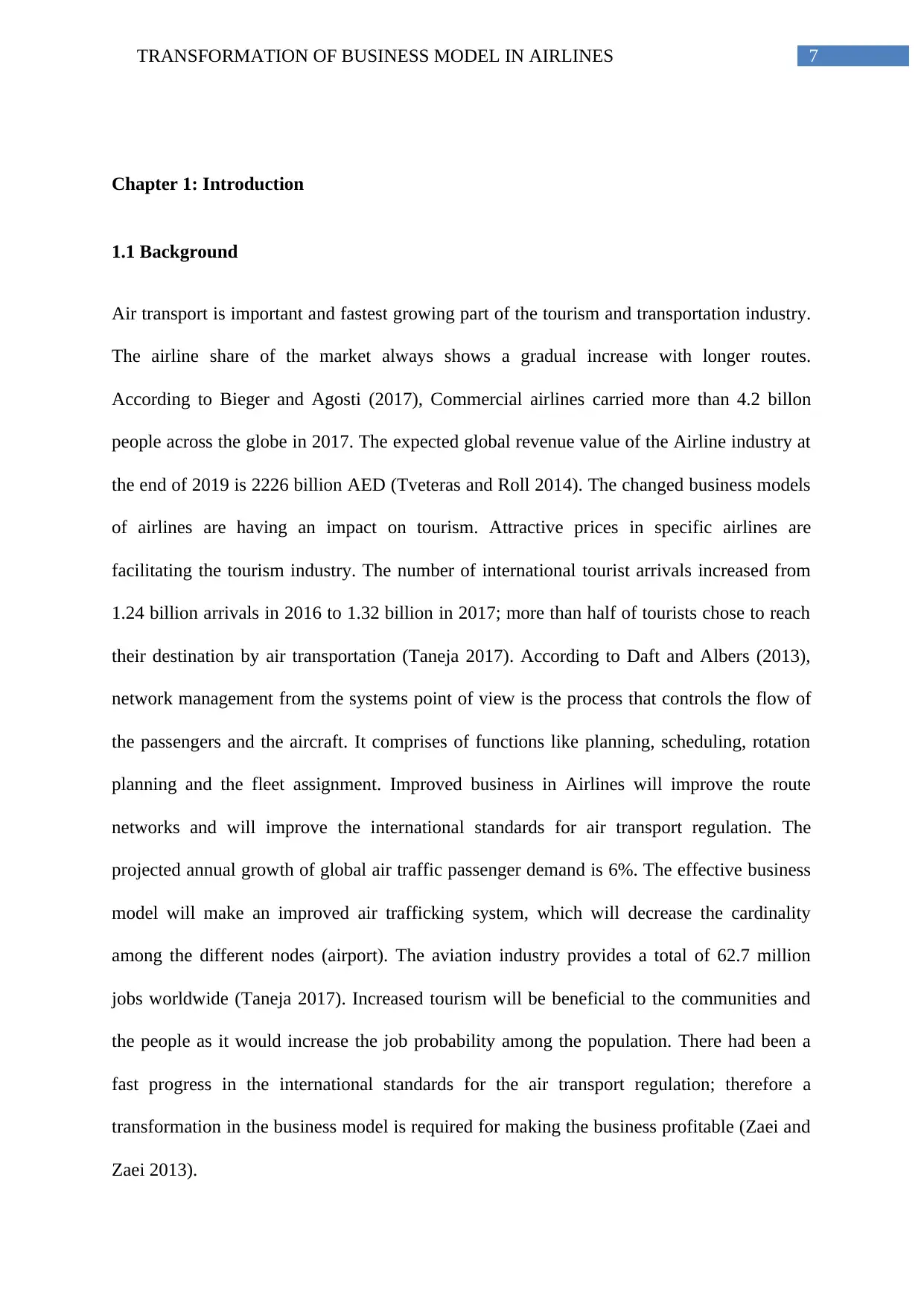
7TRANSFORMATION OF BUSINESS MODEL IN AIRLINES
Chapter 1: Introduction
1.1 Background
Air transport is important and fastest growing part of the tourism and transportation industry.
The airline share of the market always shows a gradual increase with longer routes.
According to Bieger and Agosti (2017), Commercial airlines carried more than 4.2 billon
people across the globe in 2017. The expected global revenue value of the Airline industry at
the end of 2019 is 2226 billion AED (Tveteras and Roll 2014). The changed business models
of airlines are having an impact on tourism. Attractive prices in specific airlines are
facilitating the tourism industry. The number of international tourist arrivals increased from
1.24 billion arrivals in 2016 to 1.32 billion in 2017; more than half of tourists chose to reach
their destination by air transportation (Taneja 2017). According to Daft and Albers (2013),
network management from the systems point of view is the process that controls the flow of
the passengers and the aircraft. It comprises of functions like planning, scheduling, rotation
planning and the fleet assignment. Improved business in Airlines will improve the route
networks and will improve the international standards for air transport regulation. The
projected annual growth of global air traffic passenger demand is 6%. The effective business
model will make an improved air trafficking system, which will decrease the cardinality
among the different nodes (airport). The aviation industry provides a total of 62.7 million
jobs worldwide (Taneja 2017). Increased tourism will be beneficial to the communities and
the people as it would increase the job probability among the population. There had been a
fast progress in the international standards for the air transport regulation; therefore a
transformation in the business model is required for making the business profitable (Zaei and
Zaei 2013).
Chapter 1: Introduction
1.1 Background
Air transport is important and fastest growing part of the tourism and transportation industry.
The airline share of the market always shows a gradual increase with longer routes.
According to Bieger and Agosti (2017), Commercial airlines carried more than 4.2 billon
people across the globe in 2017. The expected global revenue value of the Airline industry at
the end of 2019 is 2226 billion AED (Tveteras and Roll 2014). The changed business models
of airlines are having an impact on tourism. Attractive prices in specific airlines are
facilitating the tourism industry. The number of international tourist arrivals increased from
1.24 billion arrivals in 2016 to 1.32 billion in 2017; more than half of tourists chose to reach
their destination by air transportation (Taneja 2017). According to Daft and Albers (2013),
network management from the systems point of view is the process that controls the flow of
the passengers and the aircraft. It comprises of functions like planning, scheduling, rotation
planning and the fleet assignment. Improved business in Airlines will improve the route
networks and will improve the international standards for air transport regulation. The
projected annual growth of global air traffic passenger demand is 6%. The effective business
model will make an improved air trafficking system, which will decrease the cardinality
among the different nodes (airport). The aviation industry provides a total of 62.7 million
jobs worldwide (Taneja 2017). Increased tourism will be beneficial to the communities and
the people as it would increase the job probability among the population. There had been a
fast progress in the international standards for the air transport regulation; therefore a
transformation in the business model is required for making the business profitable (Zaei and
Zaei 2013).
Paraphrase This Document
Need a fresh take? Get an instant paraphrase of this document with our AI Paraphraser
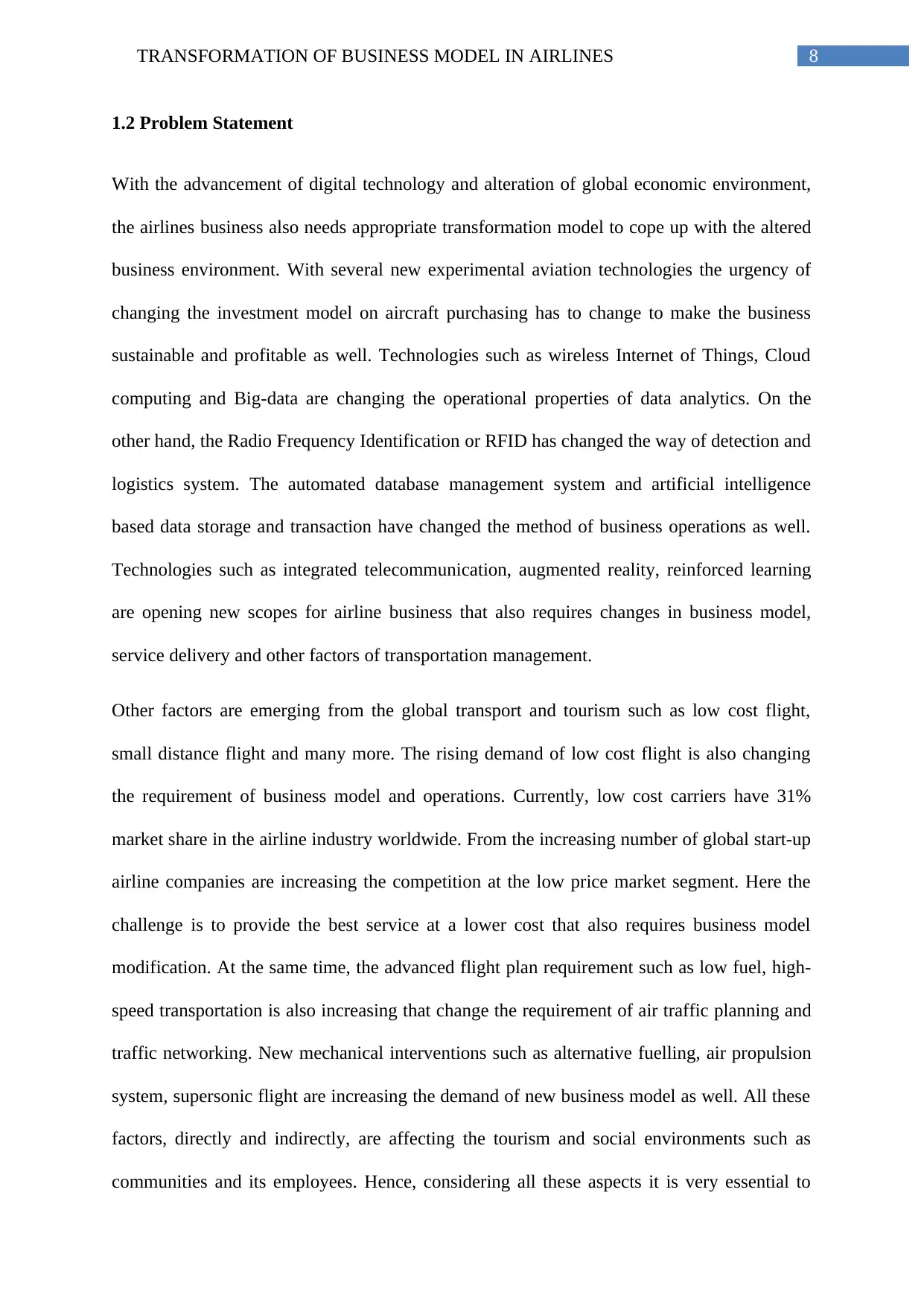
8TRANSFORMATION OF BUSINESS MODEL IN AIRLINES
1.2 Problem Statement
With the advancement of digital technology and alteration of global economic environment,
the airlines business also needs appropriate transformation model to cope up with the altered
business environment. With several new experimental aviation technologies the urgency of
changing the investment model on aircraft purchasing has to change to make the business
sustainable and profitable as well. Technologies such as wireless Internet of Things, Cloud
computing and Big-data are changing the operational properties of data analytics. On the
other hand, the Radio Frequency Identification or RFID has changed the way of detection and
logistics system. The automated database management system and artificial intelligence
based data storage and transaction have changed the method of business operations as well.
Technologies such as integrated telecommunication, augmented reality, reinforced learning
are opening new scopes for airline business that also requires changes in business model,
service delivery and other factors of transportation management.
Other factors are emerging from the global transport and tourism such as low cost flight,
small distance flight and many more. The rising demand of low cost flight is also changing
the requirement of business model and operations. Currently, low cost carriers have 31%
market share in the airline industry worldwide. From the increasing number of global start-up
airline companies are increasing the competition at the low price market segment. Here the
challenge is to provide the best service at a lower cost that also requires business model
modification. At the same time, the advanced flight plan requirement such as low fuel, high-
speed transportation is also increasing that change the requirement of air traffic planning and
traffic networking. New mechanical interventions such as alternative fuelling, air propulsion
system, supersonic flight are increasing the demand of new business model as well. All these
factors, directly and indirectly, are affecting the tourism and social environments such as
communities and its employees. Hence, considering all these aspects it is very essential to
1.2 Problem Statement
With the advancement of digital technology and alteration of global economic environment,
the airlines business also needs appropriate transformation model to cope up with the altered
business environment. With several new experimental aviation technologies the urgency of
changing the investment model on aircraft purchasing has to change to make the business
sustainable and profitable as well. Technologies such as wireless Internet of Things, Cloud
computing and Big-data are changing the operational properties of data analytics. On the
other hand, the Radio Frequency Identification or RFID has changed the way of detection and
logistics system. The automated database management system and artificial intelligence
based data storage and transaction have changed the method of business operations as well.
Technologies such as integrated telecommunication, augmented reality, reinforced learning
are opening new scopes for airline business that also requires changes in business model,
service delivery and other factors of transportation management.
Other factors are emerging from the global transport and tourism such as low cost flight,
small distance flight and many more. The rising demand of low cost flight is also changing
the requirement of business model and operations. Currently, low cost carriers have 31%
market share in the airline industry worldwide. From the increasing number of global start-up
airline companies are increasing the competition at the low price market segment. Here the
challenge is to provide the best service at a lower cost that also requires business model
modification. At the same time, the advanced flight plan requirement such as low fuel, high-
speed transportation is also increasing that change the requirement of air traffic planning and
traffic networking. New mechanical interventions such as alternative fuelling, air propulsion
system, supersonic flight are increasing the demand of new business model as well. All these
factors, directly and indirectly, are affecting the tourism and social environments such as
communities and its employees. Hence, considering all these aspects it is very essential to
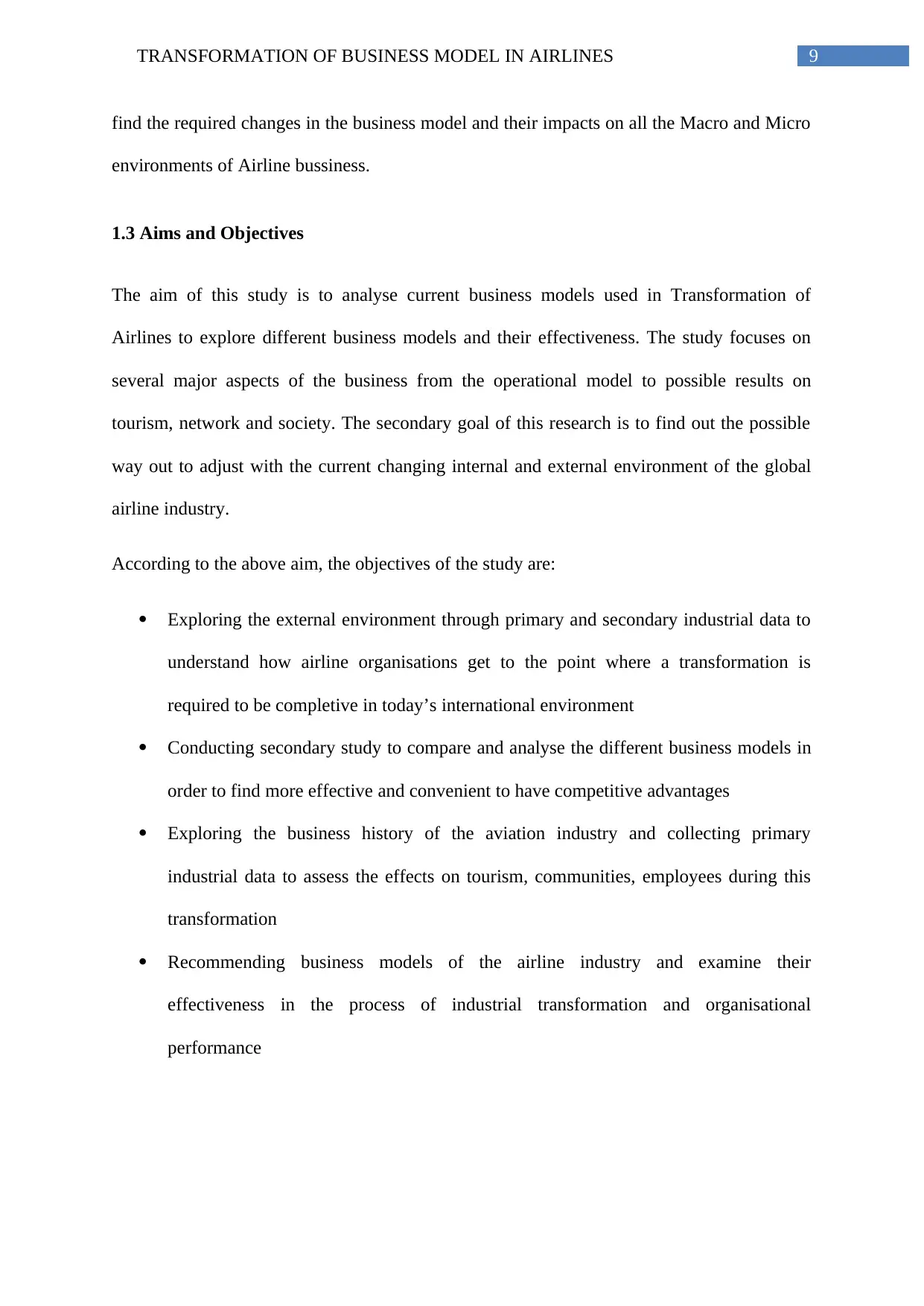
9TRANSFORMATION OF BUSINESS MODEL IN AIRLINES
find the required changes in the business model and their impacts on all the Macro and Micro
environments of Airline bussiness.
1.3 Aims and Objectives
The aim of this study is to analyse current business models used in Transformation of
Airlines to explore different business models and their effectiveness. The study focuses on
several major aspects of the business from the operational model to possible results on
tourism, network and society. The secondary goal of this research is to find out the possible
way out to adjust with the current changing internal and external environment of the global
airline industry.
According to the above aim, the objectives of the study are:
Exploring the external environment through primary and secondary industrial data to
understand how airline organisations get to the point where a transformation is
required to be completive in today’s international environment
Conducting secondary study to compare and analyse the different business models in
order to find more effective and convenient to have competitive advantages
Exploring the business history of the aviation industry and collecting primary
industrial data to assess the effects on tourism, communities, employees during this
transformation
Recommending business models of the airline industry and examine their
effectiveness in the process of industrial transformation and organisational
performance
find the required changes in the business model and their impacts on all the Macro and Micro
environments of Airline bussiness.
1.3 Aims and Objectives
The aim of this study is to analyse current business models used in Transformation of
Airlines to explore different business models and their effectiveness. The study focuses on
several major aspects of the business from the operational model to possible results on
tourism, network and society. The secondary goal of this research is to find out the possible
way out to adjust with the current changing internal and external environment of the global
airline industry.
According to the above aim, the objectives of the study are:
Exploring the external environment through primary and secondary industrial data to
understand how airline organisations get to the point where a transformation is
required to be completive in today’s international environment
Conducting secondary study to compare and analyse the different business models in
order to find more effective and convenient to have competitive advantages
Exploring the business history of the aviation industry and collecting primary
industrial data to assess the effects on tourism, communities, employees during this
transformation
Recommending business models of the airline industry and examine their
effectiveness in the process of industrial transformation and organisational
performance
⊘ This is a preview!⊘
Do you want full access?
Subscribe today to unlock all pages.

Trusted by 1+ million students worldwide
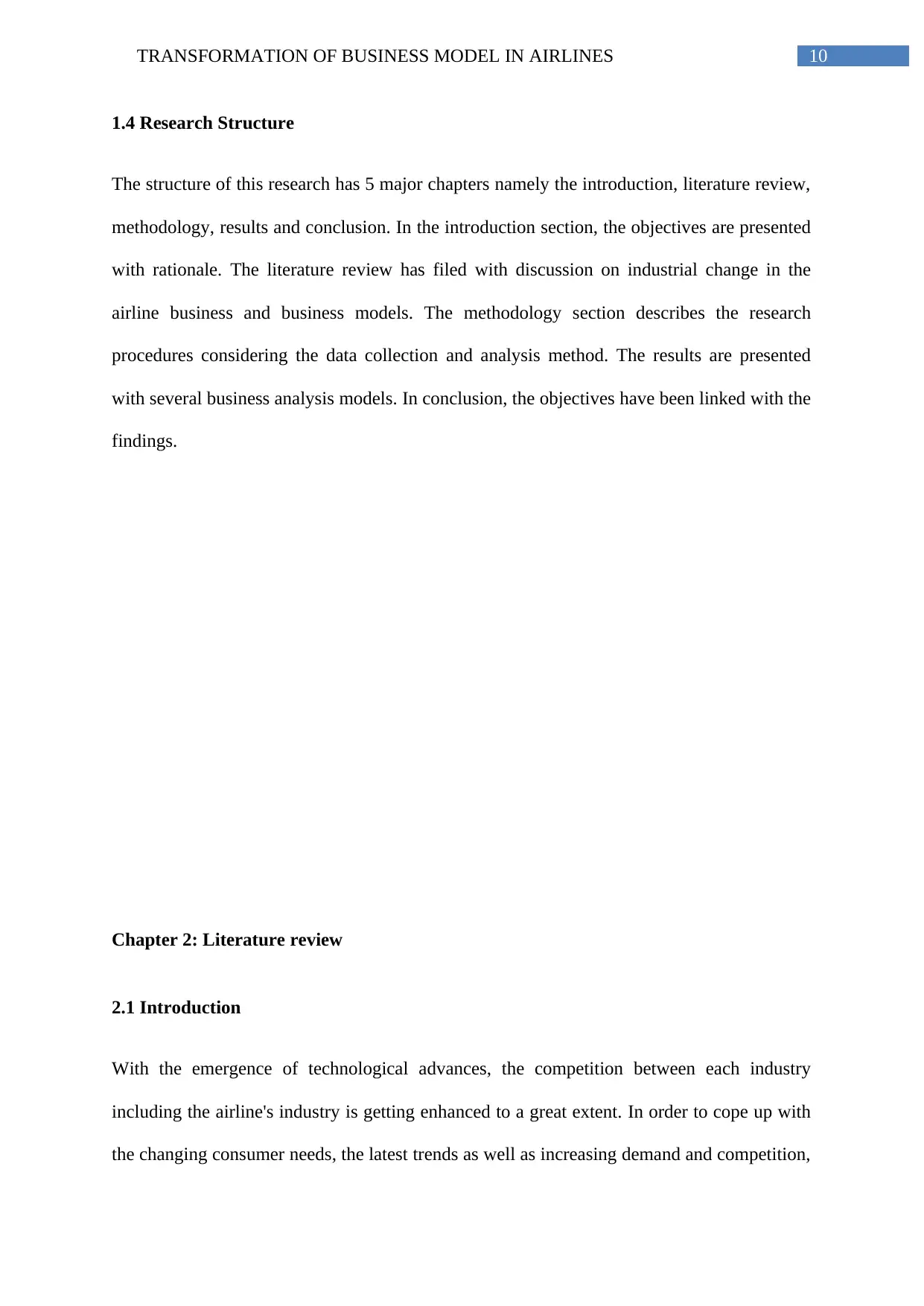
10TRANSFORMATION OF BUSINESS MODEL IN AIRLINES
1.4 Research Structure
The structure of this research has 5 major chapters namely the introduction, literature review,
methodology, results and conclusion. In the introduction section, the objectives are presented
with rationale. The literature review has filed with discussion on industrial change in the
airline business and business models. The methodology section describes the research
procedures considering the data collection and analysis method. The results are presented
with several business analysis models. In conclusion, the objectives have been linked with the
findings.
Chapter 2: Literature review
2.1 Introduction
With the emergence of technological advances, the competition between each industry
including the airline's industry is getting enhanced to a great extent. In order to cope up with
the changing consumer needs, the latest trends as well as increasing demand and competition,
Chapter1Chapter2Chapter3Chapter4Chapter5
1.4 Research Structure
The structure of this research has 5 major chapters namely the introduction, literature review,
methodology, results and conclusion. In the introduction section, the objectives are presented
with rationale. The literature review has filed with discussion on industrial change in the
airline business and business models. The methodology section describes the research
procedures considering the data collection and analysis method. The results are presented
with several business analysis models. In conclusion, the objectives have been linked with the
findings.
Chapter 2: Literature review
2.1 Introduction
With the emergence of technological advances, the competition between each industry
including the airline's industry is getting enhanced to a great extent. In order to cope up with
the changing consumer needs, the latest trends as well as increasing demand and competition,
Chapter1Chapter2Chapter3Chapter4Chapter5
Paraphrase This Document
Need a fresh take? Get an instant paraphrase of this document with our AI Paraphraser
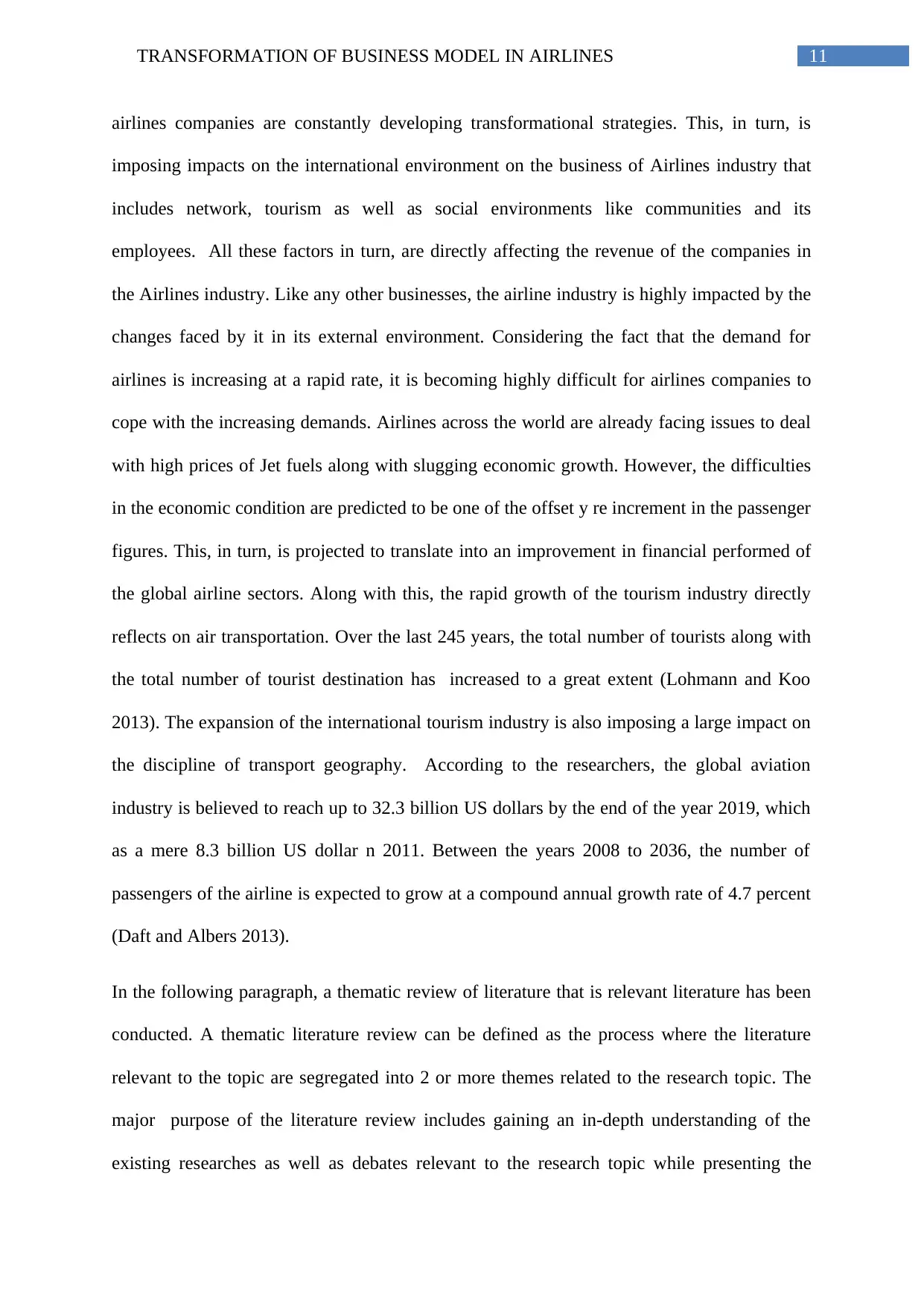
11TRANSFORMATION OF BUSINESS MODEL IN AIRLINES
airlines companies are constantly developing transformational strategies. This, in turn, is
imposing impacts on the international environment on the business of Airlines industry that
includes network, tourism as well as social environments like communities and its
employees. All these factors in turn, are directly affecting the revenue of the companies in
the Airlines industry. Like any other businesses, the airline industry is highly impacted by the
changes faced by it in its external environment. Considering the fact that the demand for
airlines is increasing at a rapid rate, it is becoming highly difficult for airlines companies to
cope with the increasing demands. Airlines across the world are already facing issues to deal
with high prices of Jet fuels along with slugging economic growth. However, the difficulties
in the economic condition are predicted to be one of the offset y re increment in the passenger
figures. This, in turn, is projected to translate into an improvement in financial performed of
the global airline sectors. Along with this, the rapid growth of the tourism industry directly
reflects on air transportation. Over the last 245 years, the total number of tourists along with
the total number of tourist destination has increased to a great extent (Lohmann and Koo
2013). The expansion of the international tourism industry is also imposing a large impact on
the discipline of transport geography. According to the researchers, the global aviation
industry is believed to reach up to 32.3 billion US dollars by the end of the year 2019, which
as a mere 8.3 billion US dollar n 2011. Between the years 2008 to 2036, the number of
passengers of the airline is expected to grow at a compound annual growth rate of 4.7 percent
(Daft and Albers 2013).
In the following paragraph, a thematic review of literature that is relevant literature has been
conducted. A thematic literature review can be defined as the process where the literature
relevant to the topic are segregated into 2 or more themes related to the research topic. The
major purpose of the literature review includes gaining an in-depth understanding of the
existing researches as well as debates relevant to the research topic while presenting the
airlines companies are constantly developing transformational strategies. This, in turn, is
imposing impacts on the international environment on the business of Airlines industry that
includes network, tourism as well as social environments like communities and its
employees. All these factors in turn, are directly affecting the revenue of the companies in
the Airlines industry. Like any other businesses, the airline industry is highly impacted by the
changes faced by it in its external environment. Considering the fact that the demand for
airlines is increasing at a rapid rate, it is becoming highly difficult for airlines companies to
cope with the increasing demands. Airlines across the world are already facing issues to deal
with high prices of Jet fuels along with slugging economic growth. However, the difficulties
in the economic condition are predicted to be one of the offset y re increment in the passenger
figures. This, in turn, is projected to translate into an improvement in financial performed of
the global airline sectors. Along with this, the rapid growth of the tourism industry directly
reflects on air transportation. Over the last 245 years, the total number of tourists along with
the total number of tourist destination has increased to a great extent (Lohmann and Koo
2013). The expansion of the international tourism industry is also imposing a large impact on
the discipline of transport geography. According to the researchers, the global aviation
industry is believed to reach up to 32.3 billion US dollars by the end of the year 2019, which
as a mere 8.3 billion US dollar n 2011. Between the years 2008 to 2036, the number of
passengers of the airline is expected to grow at a compound annual growth rate of 4.7 percent
(Daft and Albers 2013).
In the following paragraph, a thematic review of literature that is relevant literature has been
conducted. A thematic literature review can be defined as the process where the literature
relevant to the topic are segregated into 2 or more themes related to the research topic. The
major purpose of the literature review includes gaining an in-depth understanding of the
existing researches as well as debates relevant to the research topic while presenting the
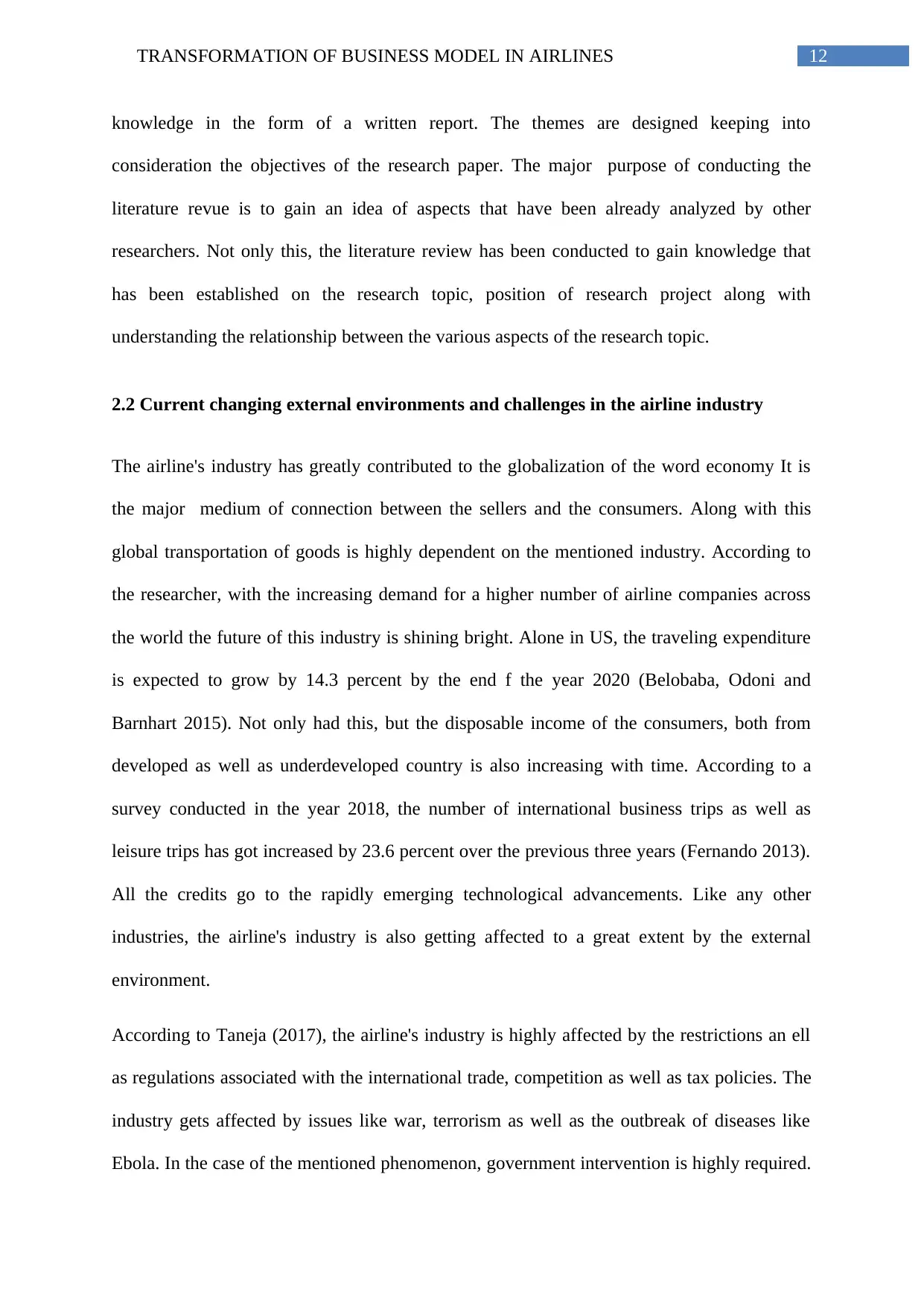
12TRANSFORMATION OF BUSINESS MODEL IN AIRLINES
knowledge in the form of a written report. The themes are designed keeping into
consideration the objectives of the research paper. The major purpose of conducting the
literature revue is to gain an idea of aspects that have been already analyzed by other
researchers. Not only this, the literature review has been conducted to gain knowledge that
has been established on the research topic, position of research project along with
understanding the relationship between the various aspects of the research topic.
2.2 Current changing external environments and challenges in the airline industry
The airline's industry has greatly contributed to the globalization of the word economy It is
the major medium of connection between the sellers and the consumers. Along with this
global transportation of goods is highly dependent on the mentioned industry. According to
the researcher, with the increasing demand for a higher number of airline companies across
the world the future of this industry is shining bright. Alone in US, the traveling expenditure
is expected to grow by 14.3 percent by the end f the year 2020 (Belobaba, Odoni and
Barnhart 2015). Not only had this, but the disposable income of the consumers, both from
developed as well as underdeveloped country is also increasing with time. According to a
survey conducted in the year 2018, the number of international business trips as well as
leisure trips has got increased by 23.6 percent over the previous three years (Fernando 2013).
All the credits go to the rapidly emerging technological advancements. Like any other
industries, the airline's industry is also getting affected to a great extent by the external
environment.
According to Taneja (2017), the airline's industry is highly affected by the restrictions an ell
as regulations associated with the international trade, competition as well as tax policies. The
industry gets affected by issues like war, terrorism as well as the outbreak of diseases like
Ebola. In the case of the mentioned phenomenon, government intervention is highly required.
knowledge in the form of a written report. The themes are designed keeping into
consideration the objectives of the research paper. The major purpose of conducting the
literature revue is to gain an idea of aspects that have been already analyzed by other
researchers. Not only this, the literature review has been conducted to gain knowledge that
has been established on the research topic, position of research project along with
understanding the relationship between the various aspects of the research topic.
2.2 Current changing external environments and challenges in the airline industry
The airline's industry has greatly contributed to the globalization of the word economy It is
the major medium of connection between the sellers and the consumers. Along with this
global transportation of goods is highly dependent on the mentioned industry. According to
the researcher, with the increasing demand for a higher number of airline companies across
the world the future of this industry is shining bright. Alone in US, the traveling expenditure
is expected to grow by 14.3 percent by the end f the year 2020 (Belobaba, Odoni and
Barnhart 2015). Not only had this, but the disposable income of the consumers, both from
developed as well as underdeveloped country is also increasing with time. According to a
survey conducted in the year 2018, the number of international business trips as well as
leisure trips has got increased by 23.6 percent over the previous three years (Fernando 2013).
All the credits go to the rapidly emerging technological advancements. Like any other
industries, the airline's industry is also getting affected to a great extent by the external
environment.
According to Taneja (2017), the airline's industry is highly affected by the restrictions an ell
as regulations associated with the international trade, competition as well as tax policies. The
industry gets affected by issues like war, terrorism as well as the outbreak of diseases like
Ebola. In the case of the mentioned phenomenon, government intervention is highly required.
⊘ This is a preview!⊘
Do you want full access?
Subscribe today to unlock all pages.

Trusted by 1+ million students worldwide
1 out of 58
Related Documents
Your All-in-One AI-Powered Toolkit for Academic Success.
+13062052269
info@desklib.com
Available 24*7 on WhatsApp / Email
![[object Object]](/_next/static/media/star-bottom.7253800d.svg)
Unlock your academic potential
Copyright © 2020–2025 A2Z Services. All Rights Reserved. Developed and managed by ZUCOL.





